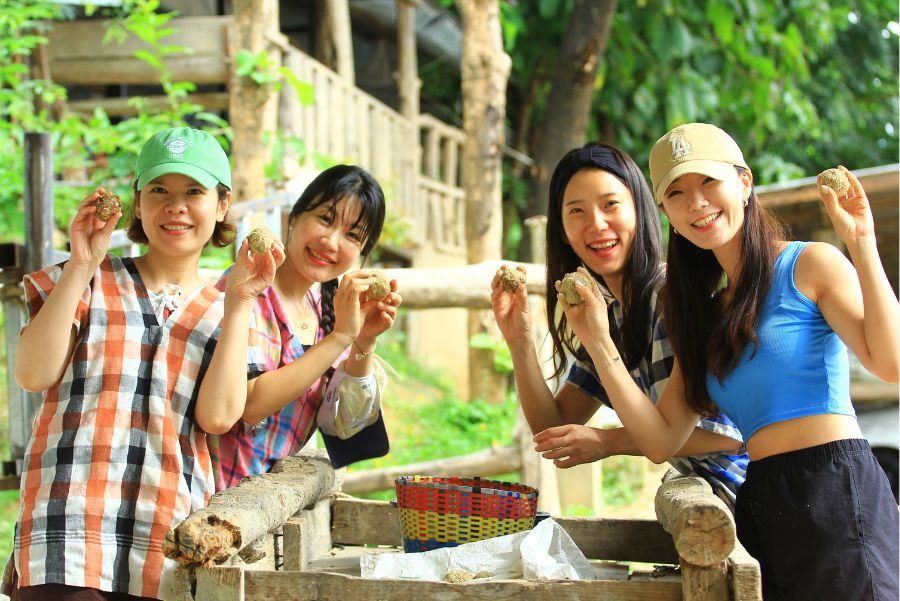
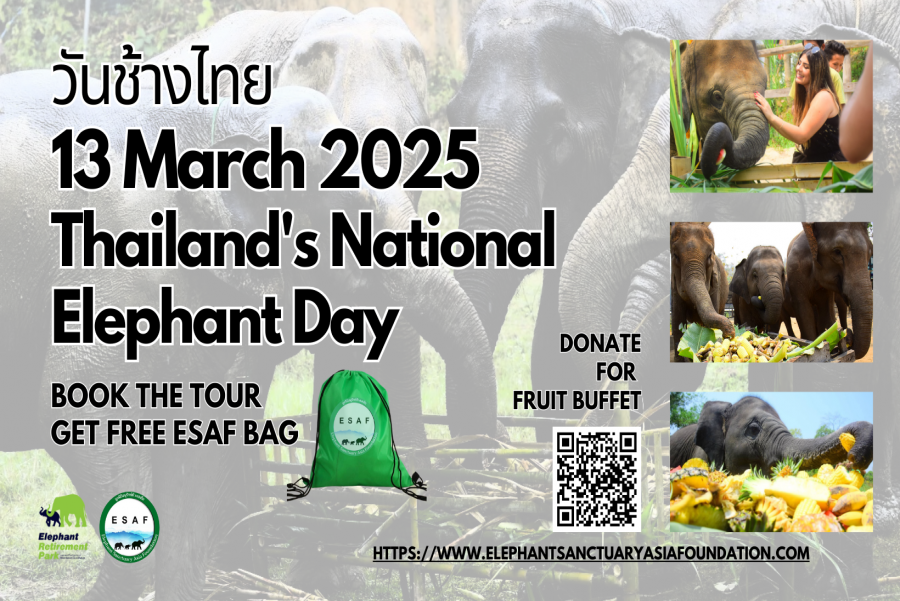
Thai National Elephant Day [13 March 2025]
Read more

Well-fed Elephants, Fulfilled Farmers Project was established to assist farmers in the
Mae Taeng and Mae Rim districts who are facing a decline in agricultural yields.
Some fruits remain in stock and cannot be sold in large quantities. The project supports local agricultural
production and ensures that elephants receive sufficient food to meet the needs of each
individual elephant.
Furthermore, the Asian Elephant Conservation Foundation recognizes the issue of haze
caused by improper farming practices in the northern region of Thailand. The foundation will
support agricultural products from farmers who refrain from burning fields or crop residues.
These farmers are required to adopt environmentally friendly methods for soil preparation
and the disposal of plants and crop residues, including not burning sugarcane or corn
leaves, as elephants can consume both the stalks and the leaves.
Donation link: https://taejai.com/th/project/anm-feed-for-elephants
Read more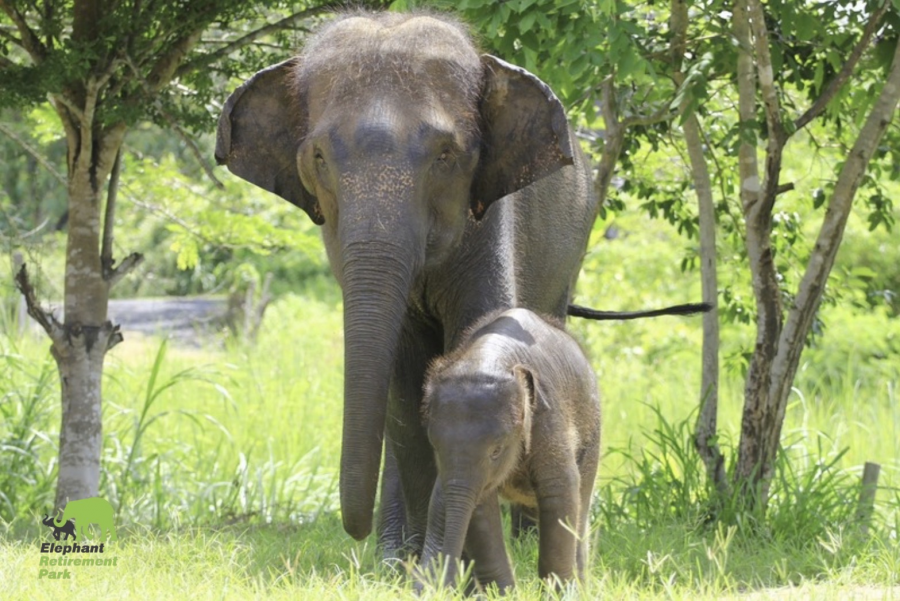
Sending our support and concern to all residents in Hat Yai Municipality and nearby areas affected by the recent flooding.
This flood situation is a significant crisis. The foundation would like to commend the strength and mutual support shown by the community, as well as the dedication of all officials and volunteers who have been working tirelessly.
We wish everyone safety,
hope the situation improves soon,
and that the community can recover steadily.
Elephant Retirement Park stands with you and will continue to support you always.
#น้ำท่วมหาดใหญ่
#อุทกภัย
#ช้างไทย

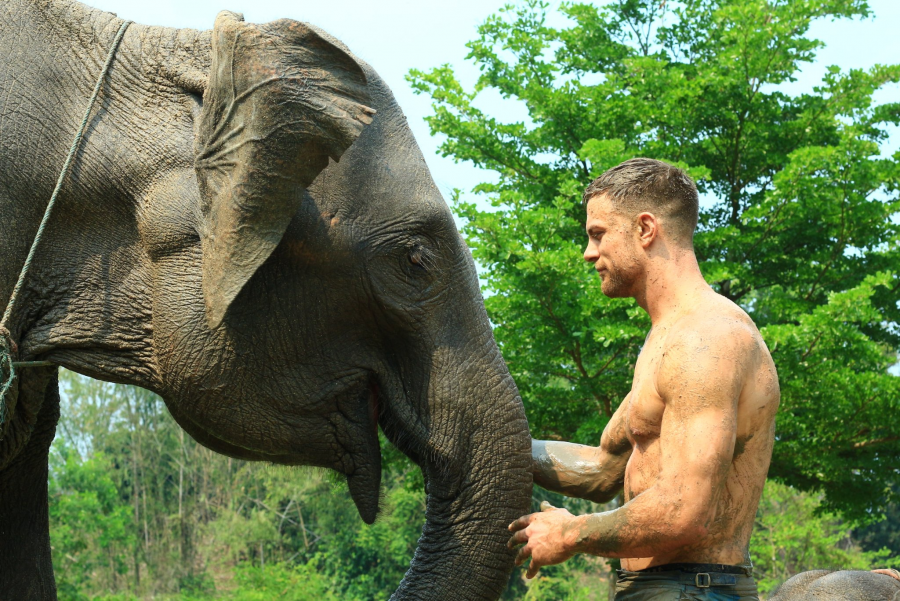
New program 2024
FEEDING ELEPHANT TRAIL 2500THB/PERSON VISIT FOR 2 ELEPHANT PARKS
If you have plan to visit PAI by motorbike, we recommend this program!
Riding by your own motorcycle or driving by your own car visit two of elephant parks for anytime between (8.30am. - 3.30pm.)
1. Start from Chiang Mai city riding to Elephant Retirement Park is a home for retired working elephants, get information about the elephants, take photo with retired elephant and baby elephant, after that enjoy to feeding them about 1hr.
https://maps.app.goo.gl/4wz2QBzyiTUBv7Bx7

2. Next ride the motorcycle to another elephant park name, Doo doi elephant home about 30mins, the new elephant sanctuary in Chiang Mai enjoy to feeding elephant and interact with the new elephants (river view).
https://maps.app.goo.gl/hxy3e3jXYm5fsNLR7
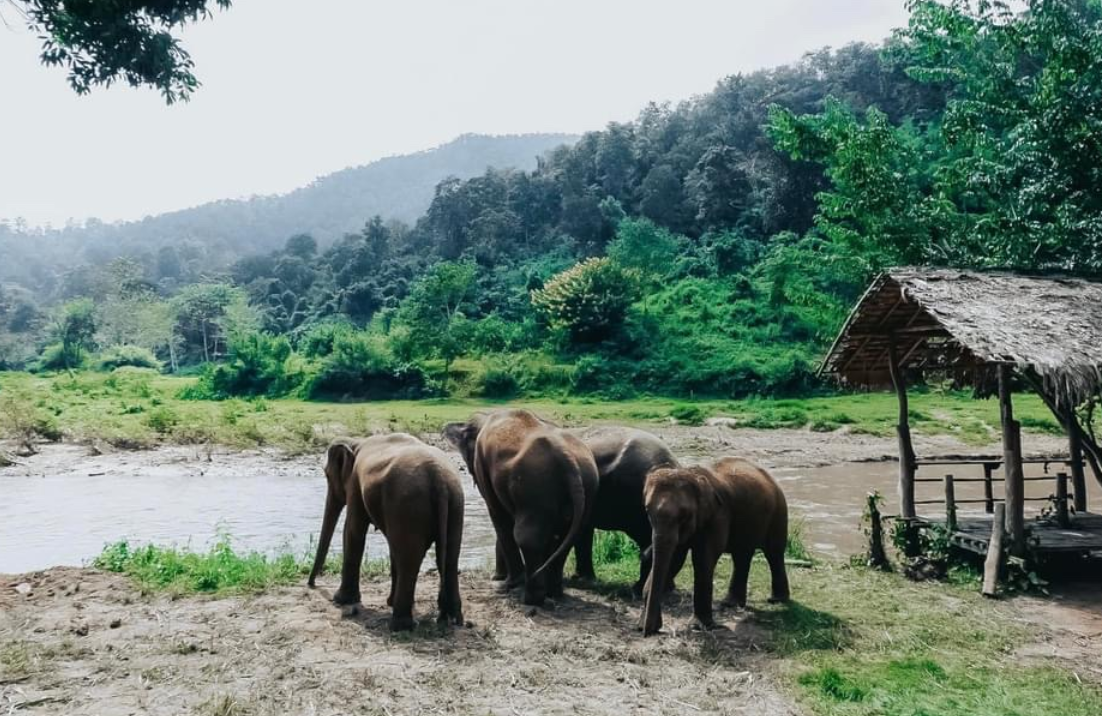
After that you can ride motorcycle to PAI (about 2hr.) or back to Chiang Mai (about 2hr.)
NOTE: No pick up service (Drive by your own car or motorcycle)
INCLUDING

Chiang Mai is the northern City of Elephants! Why? because over 100 elephant parks in Chiang Mai, We just proved for the top 3 Chiang Mai Elephant parks of 100 elephant parks that should to visit, Let see.
1. Elephant Retirement Park A sanctuary for retired elephants, free to roam and graze on the surrounding vegetation. Walk, bathe and feed them. Strict no abuse policy. All welcome. 1. Promotes and supports elephant conservation efforts by educational institutions, private individuals, government agencies and organizations in Thailand and in other countries. 2. Procures donations in support of elephant welfare, distributes funds to relevant projects, and informs donors of how their donations are being used. 3. Collaborates with Elephant Sanctuary Asia Foundation.
2. The Kanta Elephant Sanctuary is a magical home for elephants found deep in the jungle. The elephants are found in their natural jungle habitat, and you can spend the day playing and pampering them.After a scenic hilly ride to the sanctuary, you’ll be welcomed by a guide, who will teach you about elephants and their importance to Thai culture. After you can enjoy feeding the elephants some tasty snacks, getting the chance to meet each elephant one by one.
3. Elephant Rescue park was founded by a group of locals who’s goal was to rescue elephants and rescue more 10 elephants. This memorable tour starts with a scenic walk through the local forest to a tribal village. A guide will meet you and give you a brief overview of the elephants of Thailand. You are then introduced in small groups to each elephant, where you can feed them snacks.
Read more
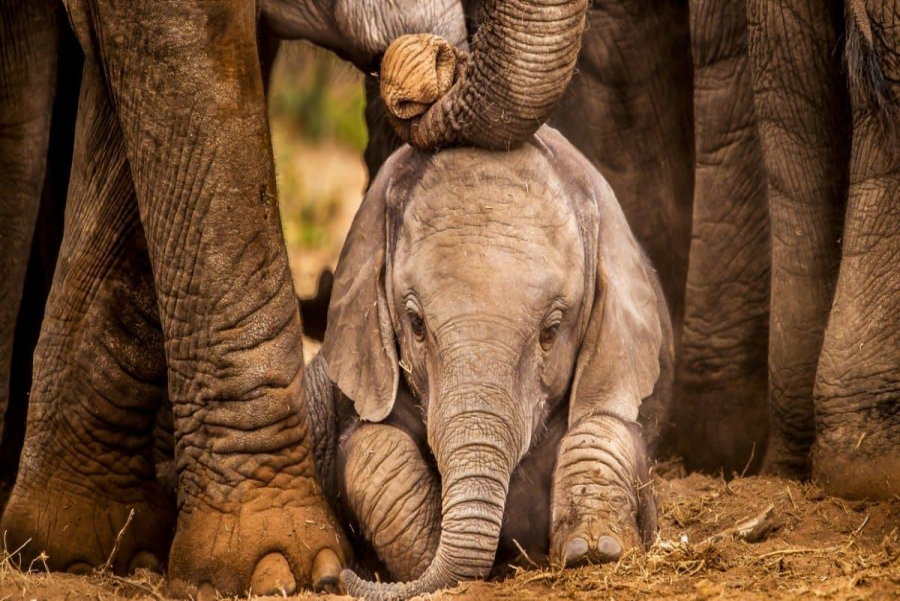
Thai elephants are not only strong and intelligent but also cute and attractive. They exhibit behaviors similar to humans in childhood, such as eating, sleeping, and playing. They drink from their mother's breast by sucking their mouths until they are 3-4 years old, then switch to plants and salt licks after weaning. Baby elephants are generally affectionate and always near their mother.
Elephants are smart, as they can avoid entering farmer's areas by using an electric fence. They love cleanliness and like to shake off soil or mud attached to vegetation before eating. However, they often face challenges when playing in water due to the loamy edge of the pond. An elephant has sacrificed himself as a ladder for his friends to step over to the shore.
A baby elephant's mischievousness and innocence often make mother and elder elephants worry, as they run toward people and cars. To suppress their fun, they are scolded and beaten by their mothers. Elephants also protect the weaker, with standing movements during danger. Older elephants, like Bunchu, have weak legs and hind legs.
To support Thai elephants and improve their quality, fundraising has been opened to build a nursing home for them. Contributions are 100 baht, with delivery fees being 50 baht nationwide. For more information, contact the Asian Elephant Conservation Foundation at 532-266-8128 or call 053-270732.
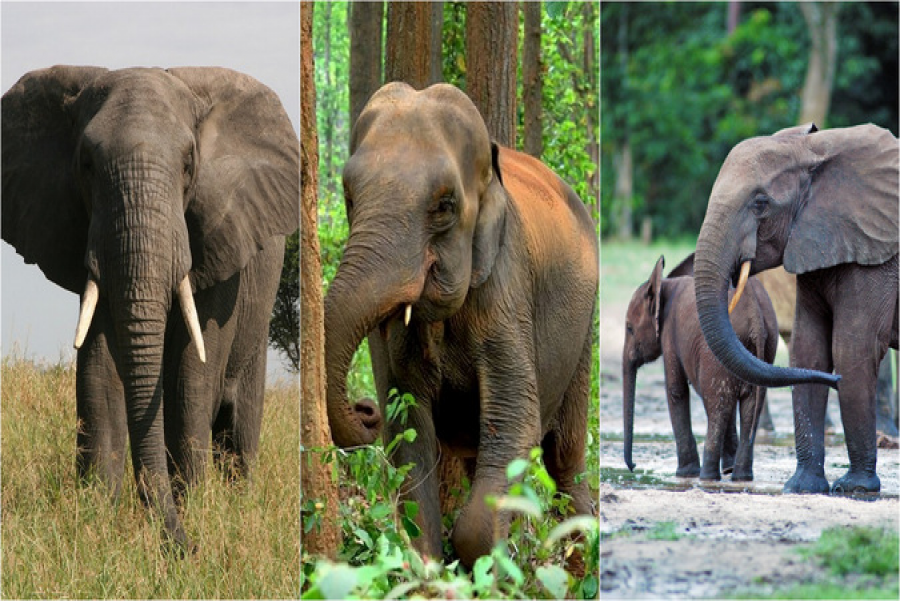
There are three species of Elephants
African Savanna (Loxodonta africana), African Forest (Loxodonta cyclones), and Asian (Elephas maximus). The African Savanna elephant can grow up to 30 meters and weigh over 13,000 lbs., making it an endangered species. The African Forest elephant is smaller weighs around 5,950 lbs. and stands up to 8.2 meters at the shoulder. The Asian elephant, on the other hand, can grow up to 18-21 meters weighs 4,000-11,000 lbs. and stands 8-10 meters at the shoulder. Both species live in the wild on the African continent south of the Sahara, while Asian elephants live in India and Southeast Asia, including Sumatra and Borneo. Their former range extended from the Himalayas to China and the Yangtze River. Elephants roam great distances to find food and water, with Mali's desert elephants in Africa migrating almost 300 miles in a year.
If you want to order a Wrist Band to support Thai elephants. and improving the quality of Thai elephants
Contribution price 100 baht, delivery fee 50 baht nationwide Order or ask for more information Inbox 532-266-8128 Siam Commercial Bank Account name Asian Elephant Conservation Foundation
Contact us: 053-270732
Credits: Global Sanctuary for Elephants
Read more
Back to 25 years ago "Pangstomee" elephant was 55 years old. she returned to his hometown with a deteriorating physical over time. After he lives in Chounan Doubutsu Zoo, Shiba City, Japan. She was among the favorite Japanese. When she got older, his body can not stand cold weather. The zoo decided to request to return her to her hometown but she soon fell sick and died peacefully in her hometown.
Thai elephant in a cage Waiting for transportation from Japan back to Thailand Published in the news area, it was stated that the owner of Sonan Dobutsu Zoo, Chiba City, Japan, made a letter to the Forest Industry Organization. Request to deliver a broken elephant named "Stomee" to the Thai Elephant Conservation Center for this elephant to return to live his final life in her hometown.
But after "Pangstomee" returned to Thailand only 13 days, the 55 years old. The elephant returned to a serious condition. Among the concerns of the followers, both Thai and Japanese. by staying at the Thai Elephant Conservation Center, Lampang Province.
After that, the story of the poor elephant who had to live abroad for over 20 years disappeared from social media. The Thai Rath news team asked a doctor who looked after elephants in the area 25 years ago, it was confirmed that "Pangstomee" had symptoms of thinning. And she did not respond to subsequent treatment until he died peacefully in the land of his birth that he left for more than 20 years
Credit : Thai Rath Online
Read more
Our Elephant Retirement Park takes care of retirement elephants that have worked hard for a long time. We don't abuse the elephant. We are not riding or showing elephants. We take good care of the elephant. Our park has many elephants. They eat a lot per day, so we have to buy a lot of food for them. You can support us by donating money to buy food such as bananas, sugarcane, pumpkin, and more herbal and medicinal because it is natural for the elephant to be sick or injured. Medicine is very important. So we raised funds to support food and medicine for them.
Donate for food at https://link.omise.co/5WVLK2SWNNXWEIW2TO8
Donate medicine at https://link.omise.co/5WVM1T62QR0Z54BNL81

Welcome the newest elephant member, Namping one of the beautiful life rescued from elephant logging camp on 9 December 2023. Namping is a 28-year-old female elephant. The trainer will stay up close watching and observing her well-being. Lanna and her family warmly welcome Namping to join her family.
Thank you to all visitors for being a part of this rescue. Your ticket will help many elephants in the future. Namping will receive the best care from the elephant park.
#elephantsanctuarychiangmai #elephantretirementpark #rescuedelephant
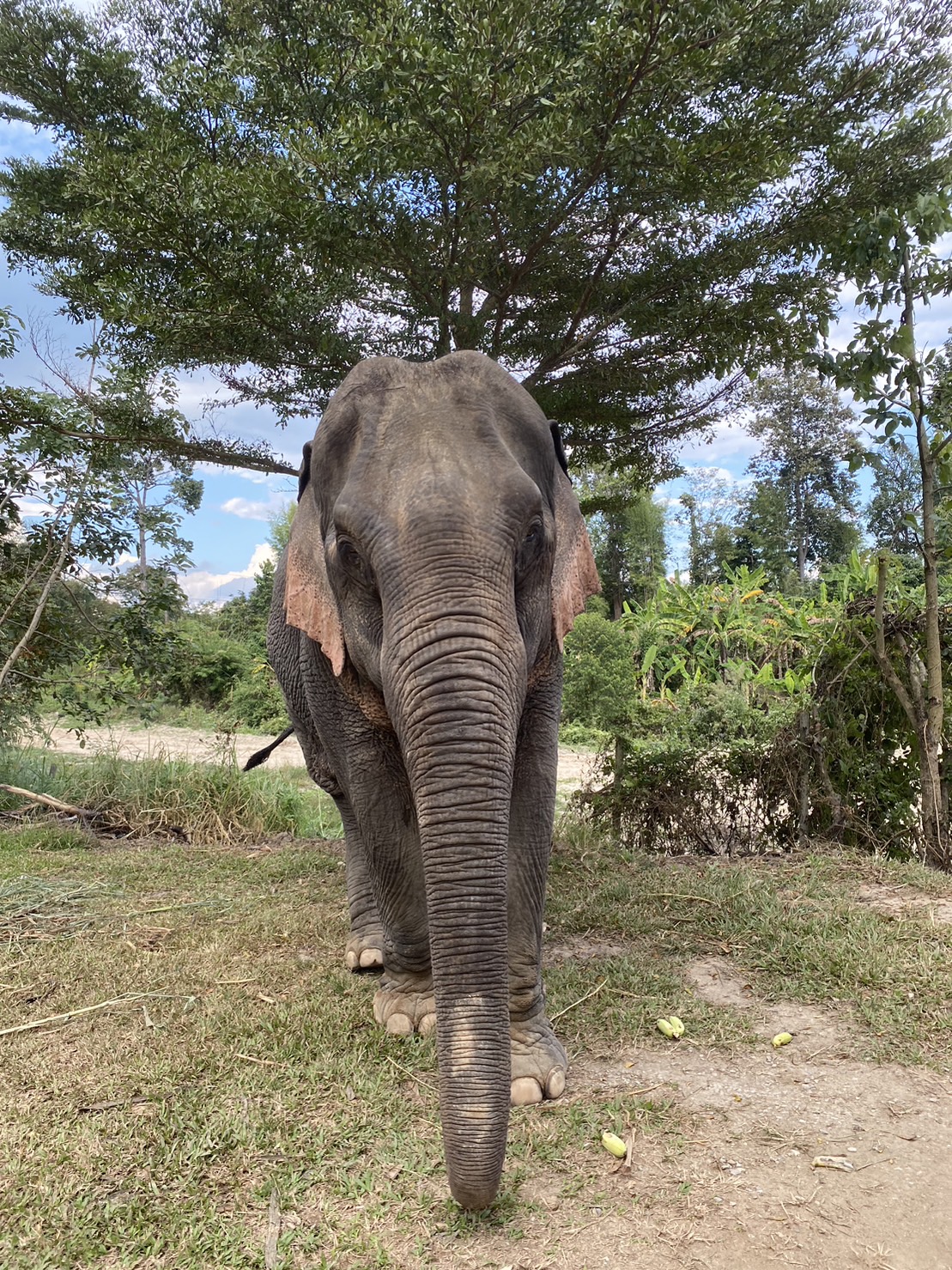
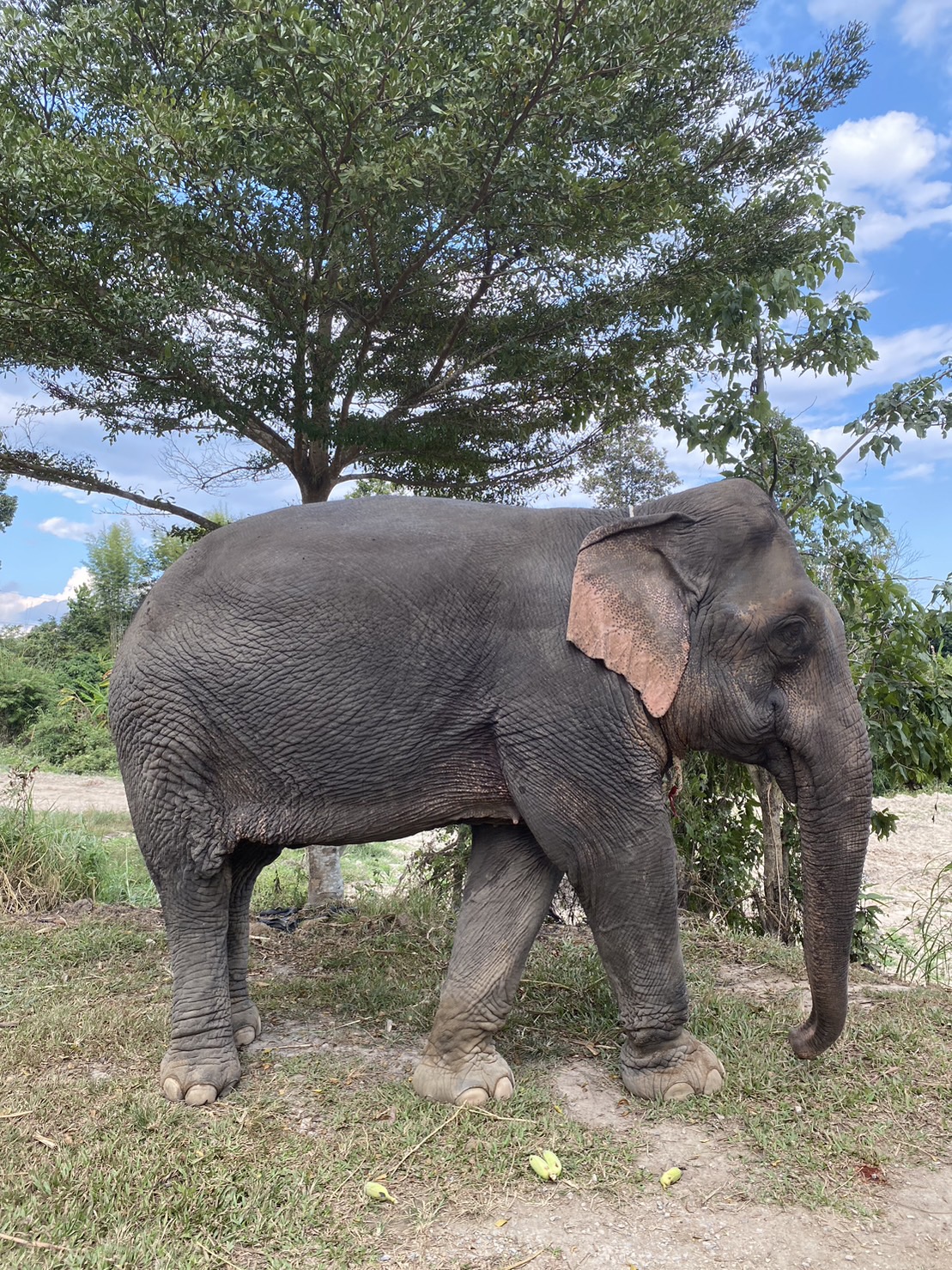
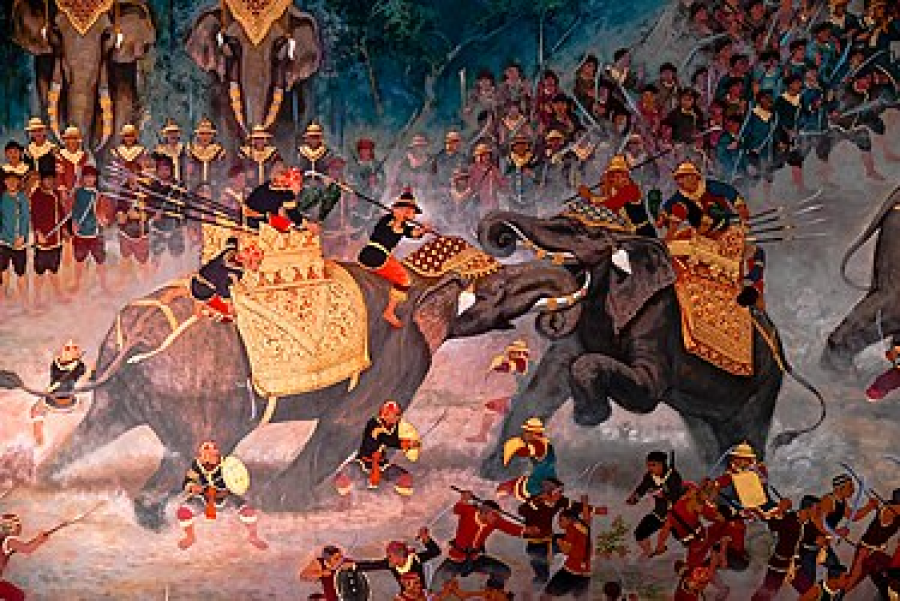
Do you know what the significance of elephants in Thailand?
Elephants and the Thai royal family.
Elephants have played an important role in Thai history and culture since ancient times. Thai civilization began in the 13th century. Kingdom of Sukhothai, Ayutthaya, and Tongbri Until now, for the Thai people, the elephant is a noble animal in Radanakhin. Clever, and worth fighting alongside the king. Especially, white elephants are chosen as elephants for various royal ceremonies because they are rare and sacred. The white elephant became a symbol of the king's imperial power. The jurisdiction of each king depends on the number of white elephants he possesses. The white elephant selected as the royal elephant will be selected from the best variety and must possess all qualifications, namely white eyes and white ceiling. White nails, white hair, white skin, white tail, and white testicles.
Combat
in Thai history, Elephants have long played an important role in protecting the country's independence. With its enormous size and strength Elephants were therefore used to fight in battles with enemies such as the Khmers and Burmese during the Sukhothai and Ayutthaya Kingdoms. Elephants were able to carry soldiers and run at speeds of up to 25 kilometers per hour. This made the elephants known as the formidable force of the army. Especially their enormous appearance, speed, strength, and ability to destroy every obstacle on the battlefield. In addition, the battle between kings with weapons on elephant backs is a rare but important uniqueness. It is an honor on the battlefield. Yutthaethi is a tradition similar to a duel on horseback between Western knights. The duels were often fatal. The elephants chosen by the king for battle were usually large bulls with broad skulls. It has long and sharp tusks that can be used to attack enemies.
Read more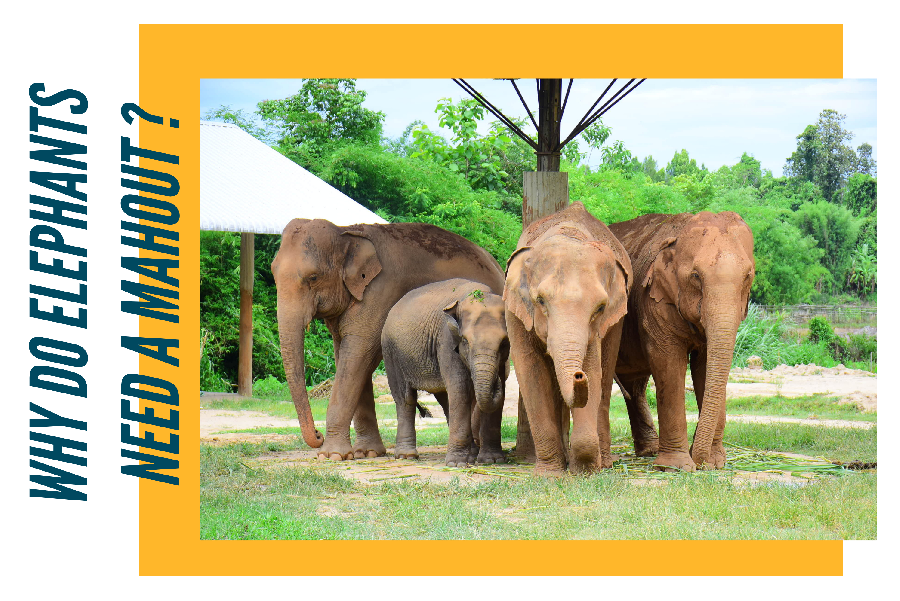
The mahout will be a person who takes care, feeds, and bathes them, and finds a warm house for them. Hence, the mahout and elephant have a close relationship with each other because they have to stay together almost every time. If the elephant doesn’t have the mahout to take care of them, they might have aggressive behavior, be untamed, and be dangerous for the tourist. If the tourist wants to take a picture or feed the elephant, they have to stay with the mahout all the time. Otherwise, it may make the elephant feel unsafe and attack the tourist because a stranger came close to them.
At the end of the day, the mahout is very necessary to elephants, and if the mahout was taken care of and had enough income, this will result in a good effect on the way of the elephant's life as well
Read more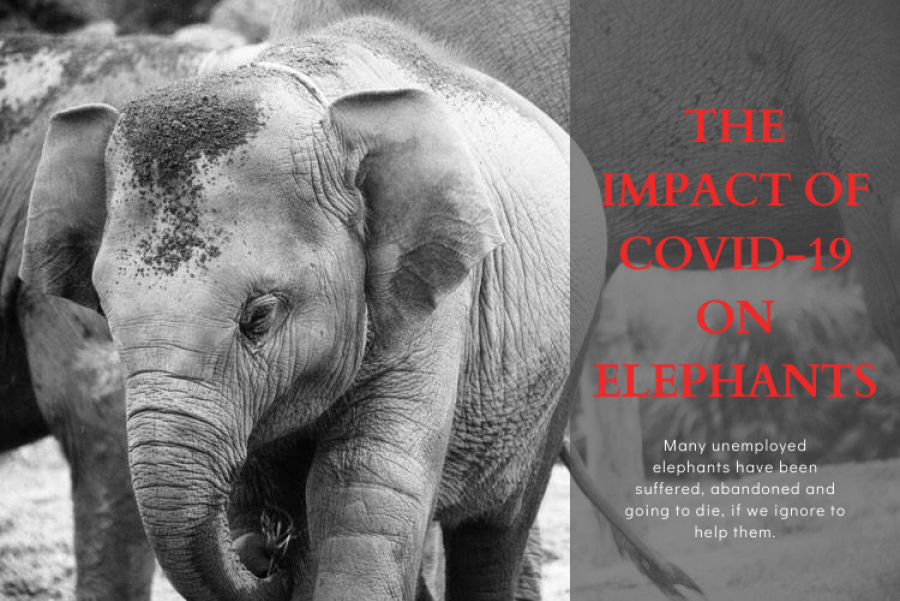
The COVID-19 outbreak changes everything in a worse way, especially the tourism industry. Currently, many elephant sanctuaries around the country are permanently closed because of the rules and preventive measures that force the tourist not to go outside of the house, so this not only affects the mahout and elephants’ life. In the past, an elephant living was comfortable and happy, they had a warm house, medicine, a personal vet, and enough food which was completely different from now.
Donate at 5322668128 (Siam Commercial Bank) Name: Elephant Sanctuary Asia Foundation or Paypal at Email: adulwit2513@gmail.com or website Any donation can exchange for the ticket when you come to visit the sanctuary (No expiry date). We will not let our elephant hungry. Thank you for your kindness, Take care of yourself and stay healthy.
Read more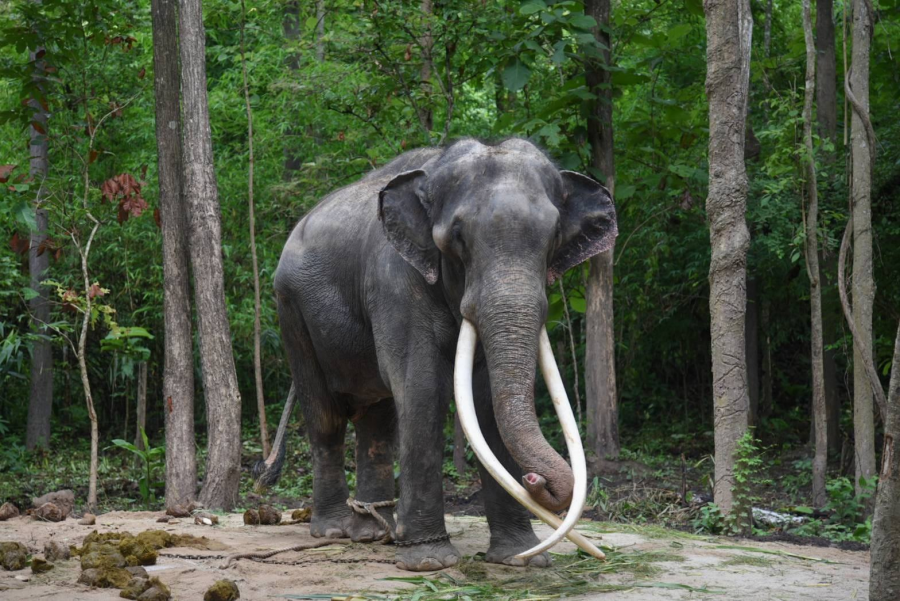
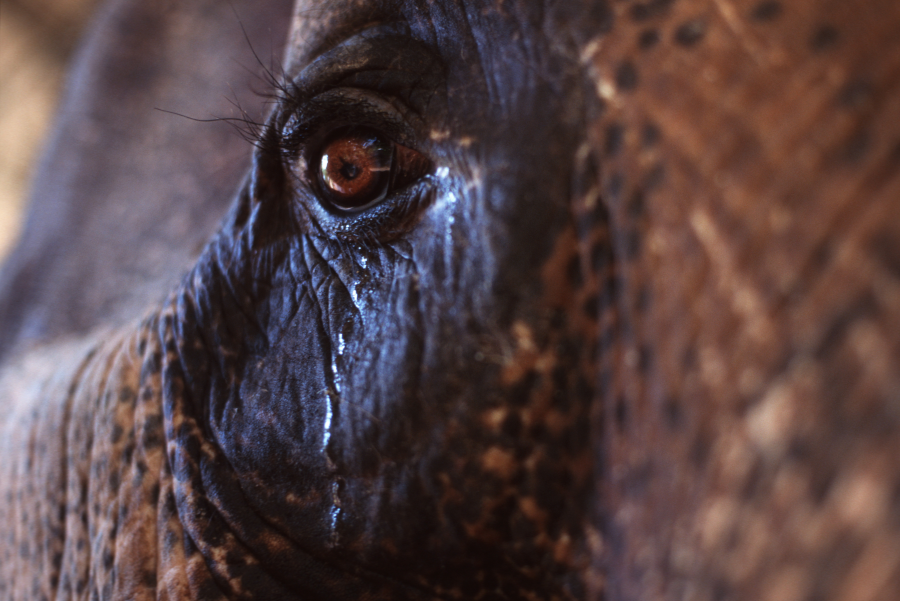

Despite what you may have seen in cartoons, elephants are unable to jump. The reason for this can be explained simply: they don't need to. Unlike other animals like kangaroos, monkeys, and frogs that jump primarily to escape predators, elephants rely on their large size and protective social groups to stay safe. Additionally, lifting a 4-ton mammal off the ground all at once is a challenging task. In fact, for elephants, it is impossible. Unlike most mammals, the structure of an elephant's leg bones is such that they are all directed downwards, lacking the necessary "spring" to propel themselves off the ground.
Read moreElephants exhibit a deep understanding of human communication. Researchers at Amboseli National Park in Kenya played back the voices of speakers from two different groups—one that preys on the elephants, and another that does not. When the elephants heard the voices of the group they feared, they were more likely to act defensively by grouping tightly together and smelling the air to investigate. What's more, the researchers found the elephants also responded with less intensity to female and younger male voices, becoming most agitated at the voices of adult males.
Elephant language skills go beyond understanding. One Asian elephant learned to mimic words in Korean. Researchers theorize that because his primary social contact while growing up was with humans, he learned to mimic words as a form of social bonding.
Credit: https://www.treehugger.com/facts-change-way-see-elephants-4869315
Read more

A baby elephant you can call that calf and weigh around 91 kg. when baby elephants are born, they can easily stand up about 20 minutes. After 2 days they can walk with the herd.  Read more
Read more

During Thailand's recent three-day holiday, Khao Yai National Park became a popular destination for family or group outings. One of the park's highlights that tourists particularly enjoy is the presence of wild elephants that inhabit the area.
Wild elephants are easily startled, which can pose risks to both humans and the animals. Some tourists have been getting too close to the elephants to take photos, potentially leading to dangerous situations. To enhance visitor safety, Khao Yai National Park has implemented additional safety measures.
The park recommends the following precautions when encountering or being near wild elephants:
(1) Maintain a distance of at least 50 meters from the elephants.
(2) When driving in areas where elephants may be present, reduce your speed to below 60 km/h to ensure visibility and avoid accidents.
(3) If you see an elephant near the roadside, do not stop your vehicle or exit to take photos.
For those who are interested in safely interacting with elephants, the Elephant Retirement Park offers programs that allow visitors to get close to the elephants without any risk. More information can be found at www.elephantretirementpark.com.


Credit:
Source and image from สำนักข่าวไทย online
Read more
In Thailand, the Loy Krathong Festival is celebrated annually in November, on the full moon night of the 12th month in the lunar calendar. In 2024, according to the Gregorian calendar, the festival will take place on November 15.
The festival is believed to have been influenced by Hinduism traditions from India. It is held to honor the Goddess of Water, Phra Mae Khongkha, as a way to show gratitude and ask for forgiveness for using and polluting water, or it may be a shared cultural tradition that has been passed down for generations across Southeast Asia.
A Krathong refers to a vessel made from banana leaves or other natural materials. The krathongs used in the Loy Krathong Festival are specially crafted from banana stalks and leaves, designed to resemble a lotus flower. These krathongs are decorated with flowers, incense sticks, and candles. People may also place coins inside as offerings. During the festival, krathongs are released into rivers as part of the ritual. In recent years, to promote environmental sustainability, krathongs made from biodegradable materials such as bread or ice have become more popular, as they cause less harm to the environment.
For those interested in experiencing the Loy Krathong Festival or visiting Thailand during this time, and who would like a close-up experience with elephants, you can explore the various programs offered by Elephant Retirement Park by visiting their website at www.elephantretirementpark.com.

Read more


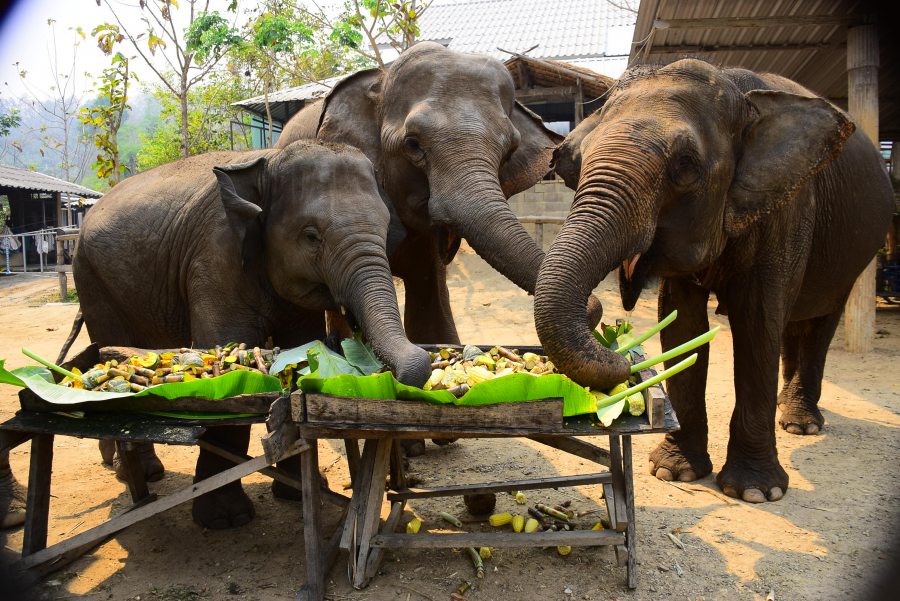
Asian elephants are large mammals found in Southeast and South Asia. They typically reach heights of 2–3.5 meters and weigh between 2,000–5,500 kilograms, living around 60–70 years. Elephants over 50 are considered elderly and need special care.
Characteristics of Elderly Elephants:
Care for Elderly Elephants:
Caring for elderly elephants is an important responsibility that requires special attention. We invite everyone to visit our Elephant Retirement Park to see these magnificent animals up close. For more information, please contact us at chiangmai10@gmail.com or call 082-5844840. You can also visit our website at https://www.elephantretirementpark.com
source: ("บ้าน ช. ช้างชรา", 2012)
Read more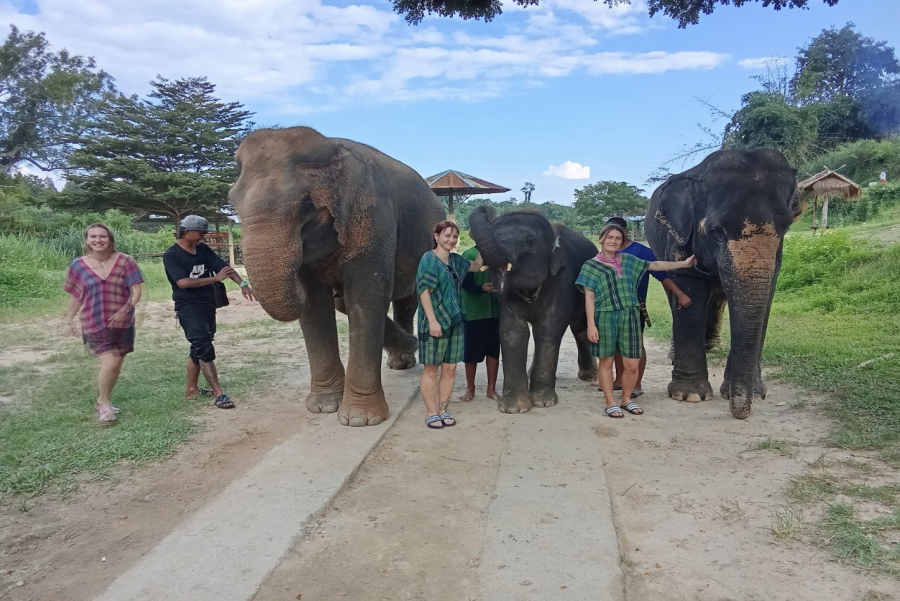
The Elephant: A Symbol of Strength and Heritage in Thai Culture
The elephant holds deep cultural and historical significance in Thailand, symbolizing bravery and resilience. In the past, Thai elephants served as essential assets, acting as vehicles in warfare, aiding construction, and playing roles in transportation and religious ceremonies. The connection between Thai people and elephants runs deep, so much so that in the early Rattanakosin period, Thailand’s national flag featured a red background with an elephant at its center, symbolizing royal authority and the king’s leadership. This design later evolved into the Thai flag we recognize today, the “Tricolor” flag.
While elephants are no longer used for transportation or warfare, they remain deeply significant in Thailand today. Thai elephants are now symbols of conservation, representing efforts to protect wildlife and natural habitats. Conservation areas have been established to preserve and care for the decreasing wild elephant populations, affected by habitat encroachment. Eco-tourism initiatives also promote respect for wildlife, avoiding practices that could harm elephants. Additionally, elephants retain an important place in Thai ceremonies and traditions, which have long been an integral part of Thai life.
Looking ahead, Thai elephants will continue to symbolize the nation, though their role may evolve to reflect modern values. Elephants are expected to inspire art, literature, films, and other forms of creative expression that emphasize their cultural and conservation value. This awareness will encourage people to learn about Thai history and inspire younger generations in Thailand and beyond to appreciate the coexistence of humans and wildlife. Furthermore, elephants may motivate research into ecosystems and animal behavior, contributing to our knowledge of biology and fostering global understanding of elephants and their natural habitats.
Though we can’t predict the exact future role of Thai elephants, today everyone can enjoy a meaningful experience with them. Learn about their behavior and the harmonious relationship between humans and wildlife at the Elephant Retirement Park, the best elephant sanctuary in Chiang Mai.
Please visit our Elephant Retirement Park to see these magnificent animals up close. For more information, please contact us at chiangmai10@gmail.com or call 082-5844840. You can also visit our website at https://www.elephantretirementpark.com
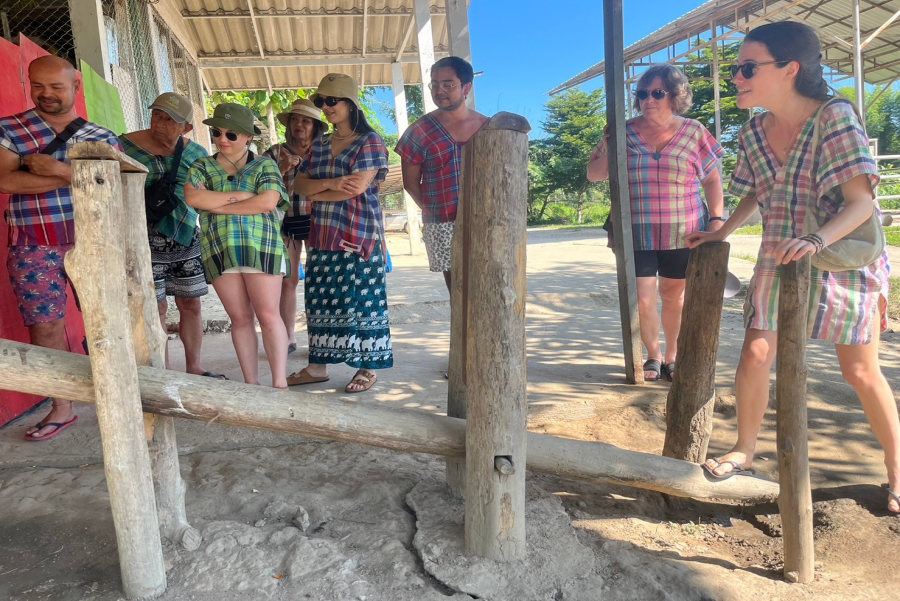
Elephants and Medicinal Plants: The Hidden Knowledge of Nature
Elephants are extraordinary creatures not only for their grace and intelligence but also for their ability to use medicinal plants to heal themselves. Their behavior in choosing these plants reflects a hidden wisdom of nature, offering us a chance to study and learn from their natural instincts.
Choosing Medicinal Plants: Knowledge Passed Down Through Generations
Elephants in the wild have been observed selecting specific plants that relieve certain ailments, a behavior often passed down within their groups. For instance, elephants may choose specific leaves when experiencing digestive issues or roots when feeling fatigued. This self-healing behavior shows an ability to “know and treat” ailments, which resembles the practices of traditional medicine in humans.
Examples of Medicinal Plants Elephants Use in the Wild
- Acacia Leaves: Acacia leaves contain anti-inflammatory compounds that help reduce infections. When an elephant has minor wounds or bruises, it may consume these leaves to alleviate inflammation.
- Parasitic Plants: Some elephants eat parasitic plants to improve digestive health or cleanse toxins from their bodies.
- Bitter Herbs and Grasses: Elephants with stomach discomfort or digestive imbalances often consume bitter herbs and grasses that help stimulate digestion and restore balance.
Learning from Elephants to Inspire Traditional Medicine
The way elephants select medicinal plants has inspired many indigenous tribes in Africa and Asia to learn from animal behavior, particularly that of elephants, to discover new herbal remedies. Observing elephants has occasionally led to the discovery of new medicinal plants with healing properties.
Research and the Importance of Conservation
Scientific interest in the medicinal plant use of elephants remains strong, as understanding this behavior could reveal natural treatment methods beneficial to humans. Additionally, it underscores the importance of conserving elephants and their natural habitats, as their instinctual knowledge might contribute to future advancements in health and medicine.
Elephants’ selection of medicinal plants demonstrates the hidden knowledge within nature. They don’t just eat plants for survival; they carefully choose plants that help treat various ailments. This natural wisdom reminds us of the value of conserving animals and ecosystems. In a world where all things are interconnected, what elephants do today may provide answers for human health in the future.
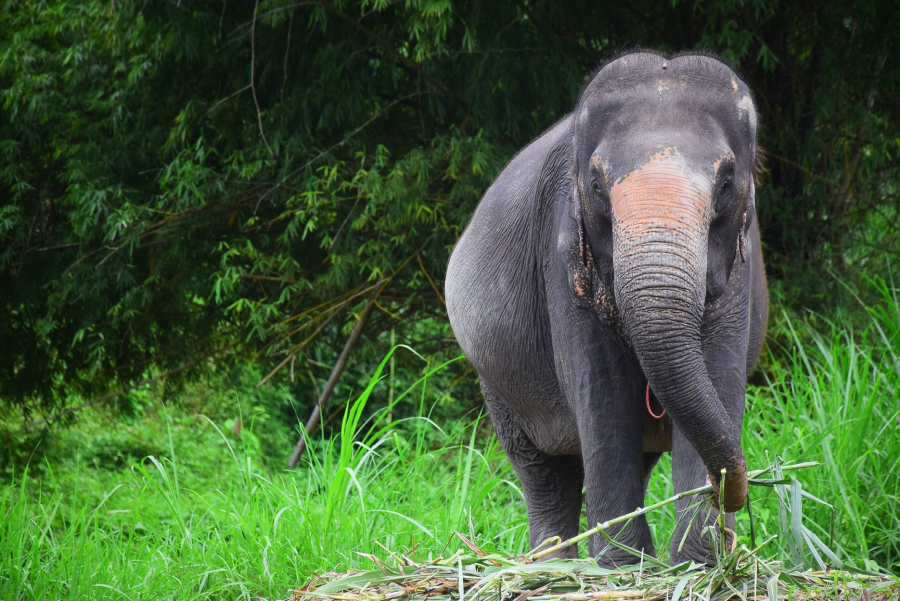
Elephants: Majestic Beings with Remarkable Intelligence and Emotional Depth
Elephants are more than just majestic creatures roaming the wilderness; they are complex animals with remarkable intelligence and profound emotional depth. Often referred to as "gentle giants," elephants possess cognitive abilities and social skills that rival those of many other species, making them stand out in the animal kingdom. Exploring the intelligence and emotional capabilities of elephants not only deepens our understanding of them but also reinforces the importance of protecting these unique beings.
Elephants are known for their impressive memory, which helps them navigate vast landscapes and recall crucial resources like water sources over long distances. They can remember specific locations and paths they haven't traveled for years, and they even pass down knowledge of these routes through generations. Studies have shown that elephants can solve problems, use tools, and display self-awareness. For example, elephants can recognize themselves in mirrors—a rare trait shared only with a few species, including great apes and dolphins.
Additionally, elephants demonstrate complex communication skills, using a combination of vocalizations, body language, and infrasound vibrations to convey messages over long distances. This sophisticated form of communication helps them coordinate within their herd, warn others of danger, and even express emotions.
Elephants are social animals with deep bonds within their family groups, especially between mothers and calves. These familial bonds can last a lifetime, and elephants are known to exhibit grief when a loved one dies. There have been instances where elephants return to the bones of deceased relatives, gently caressing them with their trunks, as if acknowledging their loss.
Elephants also exhibit joy, playfulness, empathy, and compassion. They are known to comfort one another in times of distress by using their trunks to touch and reassure each other, much like humans might offer a comforting hand. This capacity for empathy is one of the most remarkable aspects of elephant behavior, making them seem more like sentient beings than typical animals.
The intelligence and emotional depth of elephants call for a deeper level of respect and protection. Recognizing that these creatures experience emotions and form memories similar to our own reinforces the ethical obligation to ensure their survival. In regions where elephants face threats from habitat destruction and poaching, understanding their complex nature can help guide conservation efforts that respect their unique needs.
In conclusion, elephants are more than just iconic animals of the wilderness. Their intelligence, memory, emotional range, and intricate social bonds reveal a complexity that is both awe-inspiring and humbling. By acknowledging and respecting the inner lives of elephants, we can build stronger, more ethical conservation efforts to protect these gentle giants and ensure that future generations will have the privilege of sharing the world with them.
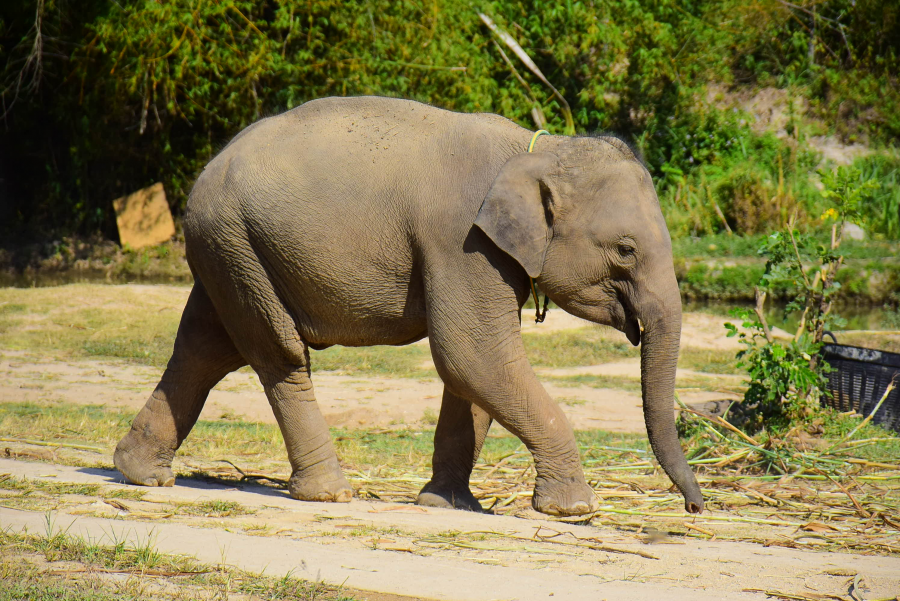
Elephant Body Language: What Their Gestures Reveal About Their Emotions and Thoughts
Elephants, known for their intelligence and emotional depth, communicate not only through sounds but also through subtle body language. Observing their gestures and movements provides insight into their moods, social dynamics, and responses to their environment. Understanding the body language of elephants can reveal much about their emotional state and thoughts, helping us to better protect and respect these remarkable animals.
One of the most recognizable behaviors in elephants is their ear flapping. This movement serves a dual purpose. Physically, it helps regulate their body temperature by creating airflow over blood vessels in the ears. However, it also serves as a signal of excitement or agitation. Rapid ear flapping can indicate that an elephant is alert or aware of something unusual in its surroundings. A head shake, sometimes accompanied by ear flapping, often signals a warning or a way to discourage other animals from getting too close.
Elephants use their trunks as multi-functional tools, akin to a human hand. When an elephant holds its trunk high and waves it side to side, it may be trying to detect distant scents, showing curiosity or caution about what lies ahead. A gently extended trunk toward another elephant signifies friendly greetings, while intertwining trunks reflects bonding and affection.
If an elephant curls its trunk under its body or swings it low, this can indicate relaxation or contentment. However, if an elephant tucks its trunk tightly to its chest, it might be feeling insecure or threatened, prepared to pull back or defend itself if necessary.
The position and movement of an elephant’s tail can reveal its emotional state. When relaxed, the tail sways naturally. However, if the tail is held stiffly out or swings quickly from side to side, it often indicates annoyance or frustration. A tucked tail, much like in other animals, is a sign of fear or anxiety. Elephants may also slap their tails as a way to signal to others that they’re feeling irritable or agitated.
Elephants are known for their ability to intimidate when feeling threatened. They may stand tall, spread their ears wide, and hold their heads high to appear larger and more intimidating. This classic “threat display” is a warning signal, meant to ward off perceived danger or intruders. When an elephant feels particularly threatened, it may begin to sway or stamp its feet—a powerful display of strength meant to demonstrate that it is prepared to defend itself or its family.
Elephants, especially young ones, exhibit playful behaviors that are endearing to watch. Playful elephants may chase each other, roll on the ground, or playfully push each other with their trunks and heads. These behaviors often reveal feelings of joy and excitement. Sometimes, elephants trumpet with excitement or joy, and playful chasing can strengthen social bonds among herd members.
Elephants show empathy through physical touch. When a member of the herd is distressed, others may reach out with their trunks to gently touch or caress the troubled elephant, offering comfort much like a hug or pat on the back. Mothers and calves often engage in close body contact as a form of reassurance, and older elephants may guide younger ones with nudges from their trunks or legs.
Elephant body language is a window into their inner world of thoughts and emotions. By learning to interpret their gestures, we can gain a deeper respect for their complex lives and interactions. Elephants are not only creatures of physical strength but also beings of emotional richness. Observing and understanding their body language enhances our ability to protect and coexist with these intelligent giants, preserving a connection that has lasted throughout human history.
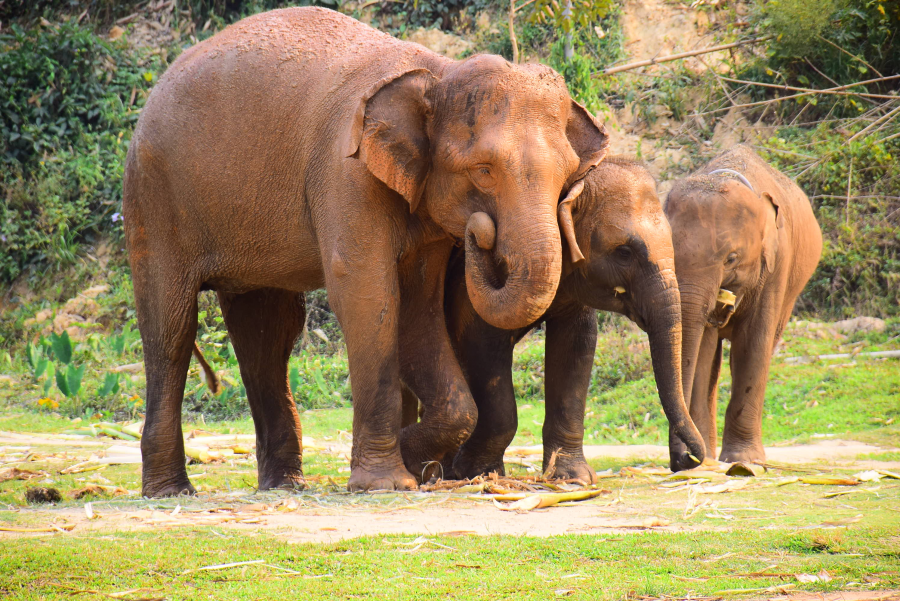
“Trunks & Tales: An Elephant’s Unforgettable Journey”
Elephants are widely recognized for their remarkable memory, a trait admired by scientists and the general public alike. Their memories go beyond remembering locations, food sources, or migration routes; they extend to recalling past events and interactions with individuals, whether human or animal.
Wild elephants in Africa and Asia exhibit an impressive ability to remember distant water sources and feeding grounds. During dry seasons, they often travel hundreds of kilometers to find these resources. Studies have shown that older matriarchs lead their herds with precise knowledge of where to find water and food, even remembering which locations to visit during specific times of the year. These experienced elephants can guide their herd along the safest and most efficient paths, which is vital for survival.
Elephants can remember not only other elephants but also people they have encountered, even after years have passed. Researchers have observed that elephants recognize individuals who have either treated them well or harmed them, displaying distinct responses based on these memories. When they encounter people who have previously cared for them, they may show affection by using vocalizations or touching them with their trunks. Conversely, when encountering someone who has mistreated them, they may show physical signs of distress or anger, like swinging their trunk aggressively or keeping a defensive distance.
In addition to remembering locations and individuals, elephants have emotional memories tied to experiences of joy, sadness, and loss. For instance, elephants are known to grieve for deceased herd members, often revisiting the place where they passed away, staying there for extended periods, or even returning to the spot repeatedly over the years. This behavior reflects the complexity of their emotions and their deep social bonds.
The memory of elephants is not only scientifically fascinating but essential to their survival in the wild. It enables them to recall food and water sources during scarcity, avoid dangerous places, and remember individuals who pose threats. Their ability to connect past experiences with present situations is a key to their survival and the protection of their herd.
Elephants' exceptional memory makes them not only astonishing creatures but also invaluable members of their ecosystems. Through their rich memories, they tell stories of the natural world, weaving together generations of knowledge that help them—and those who study them—better understand their environment.
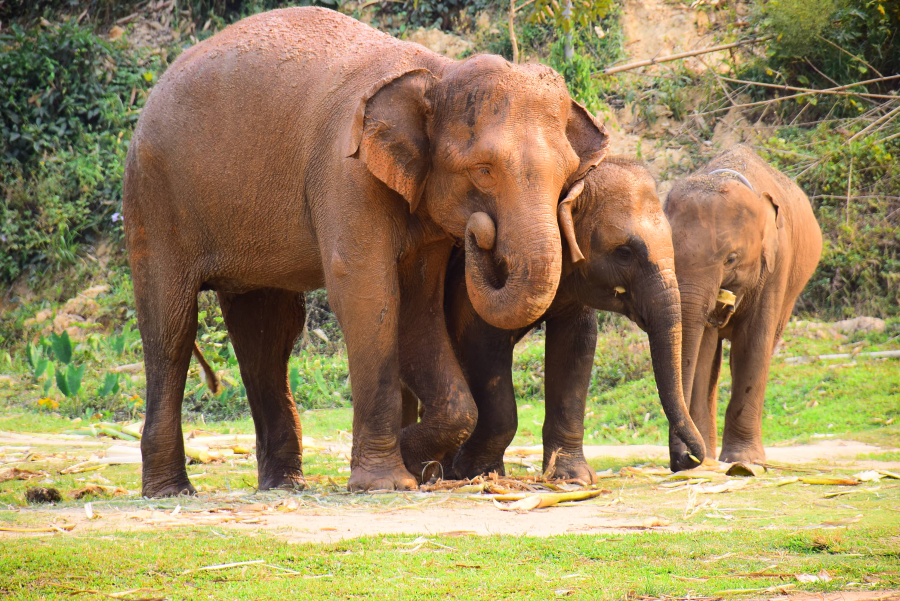
“Trunks & Tales: An Elephant’s Unforgettable Journey”
Elephants are widely recognized for their remarkable memory, a trait admired by scientists and the general public alike. Their memories go beyond remembering locations, food sources, or migration routes; they extend to recalling past events and interactions with individuals, whether human or animal.
Wild elephants in Africa and Asia exhibit an impressive ability to remember distant water sources and feeding grounds. During dry seasons, they often travel hundreds of kilometers to find these resources. Studies have shown that older matriarchs lead their herds with precise knowledge of where to find water and food, even remembering which locations to visit during specific times of the year. These experienced elephants can guide their herd along the safest and most efficient paths, which is vital for survival.
Elephants can remember not only other elephants but also people they have encountered, even after years have passed. Researchers have observed that elephants recognize individuals who have either treated them well or harmed them, displaying distinct responses based on these memories. When they encounter people who have previously cared for them, they may show affection by using vocalizations or touching them with their trunks. Conversely, when encountering someone who has mistreated them, they may show physical signs of distress or anger, like swinging their trunk aggressively or keeping a defensive distance.
In addition to remembering locations and individuals, elephants have emotional memories tied to experiences of joy, sadness, and loss. For instance, elephants are known to grieve for deceased herd members, often revisiting the place where they passed away, staying there for extended periods, or even returning to the spot repeatedly over the years. This behavior reflects the complexity of their emotions and their deep social bonds.
The memory of elephants is not only scientifically fascinating but essential to their survival in the wild. It enables them to recall food and water sources during scarcity, avoid dangerous places, and remember individuals who pose threats. Their ability to connect past experiences with present situations is a key to their survival and the protection of their herd.
Elephants' exceptional memory makes them not only astonishing creatures but also invaluable members of their ecosystems. Through their rich memories, they tell stories of the natural world, weaving together generations of knowledge that help them—and those who study them—better understand their environment.

Calls from the Wild: The Silent Language of Elephant Communication
Elephants are known for their complex and fascinating communication skills. Beyond the trumpeting or rumbling sounds we commonly hear, elephants use a form of low-frequency sound called **infrasound**, which ranges between 1-20 Hz. These frequencies are too low for human ears to detect, but elephants can perceive them up to 10 kilometers away. Infrasound plays a vital role in elephants' daily lives, serving as a means for warning signals, herd communication, and territory marking.
Infrasound and Long-Distance Communication
Infrasound is the channel elephants use to communicate across vast distances, particularly in tropical forests or open savannas. Through these sounds, elephants can alert herds to various situations, such as the discovery of water sources, the approach of predators or humans, and the arrival of a male elephant during mating season. Female elephants may respond to these signals depending on their interest, creating a highly responsive communication network that ensures the safety and continuity of the herd.
Social Structure and Elephant Vocalizations
The sounds elephants use reveal the intricate dynamics within their social structure. Herds are typically led by an older female, and infrasound helps maintain connectivity among members even when they spread out. Moreover, elephants use these low-frequency sounds to comfort distressed individuals or young calves, with older elephants teaching these vocalizations to calves from an early age.
The Role of Infrasound in Elephant Conservation
Researchers are now leveraging infrasound to track elephants’ behavior and movements. By monitoring these low-frequency sounds, conservationists can locate herds, reducing potential conflicts with nearby communities and minimizing the risks of harmful encounters. This tracking also provides insights into migration patterns and resource use, helping to inform conservation strategies.
Infrasound communication not only connects elephants within their groups but also serves as a critical tool in conservation efforts. Understanding these sounds could pave the way for a future that preserves both elephants and their natural habitats.

What is Musth?
Musth is a natural physiological state in male elephants characterized by hormonal changes that cause mood swings and aggressive behavior. Elephants in musth exhibit the following symptoms:
Causes
Musth results from a surge in testosterone levels during certain periods of the year, which is a natural occurrence indicating reproductive readiness in male elephants.
Managing Elephants in Musth
Musth typically lasts for a short period and subsides once the hormonal levels normalize.



Why Do Elephant Take Mud Baths?
Taking a mud bath isn't just a playful activity-it's a survival strategy deeply rooted in elephant biology and social behavior.
Benefits of Mud Bathing
1.Body Temperature Regulation
Elephants lack sweat glands. Mud acts as a natural coolant, helping them stay cool in hot weather.
2. Natural Sunblock and Insect Repellent
A thick layer of mud protects their sensitive skin from harsh UV rays and irritating insect bites.
3. Skin Healing and Protection
Mud helps soothe minor cuts and scratches, and minerals in the mud may even aid in healing skin irritations.
4. Strengthening Social Bonds
Mud bathing is often a group activity. Elephants enjoy spraying mud on each other and rubbing it in-a behavior that reinforces social ties within the herd.
Read more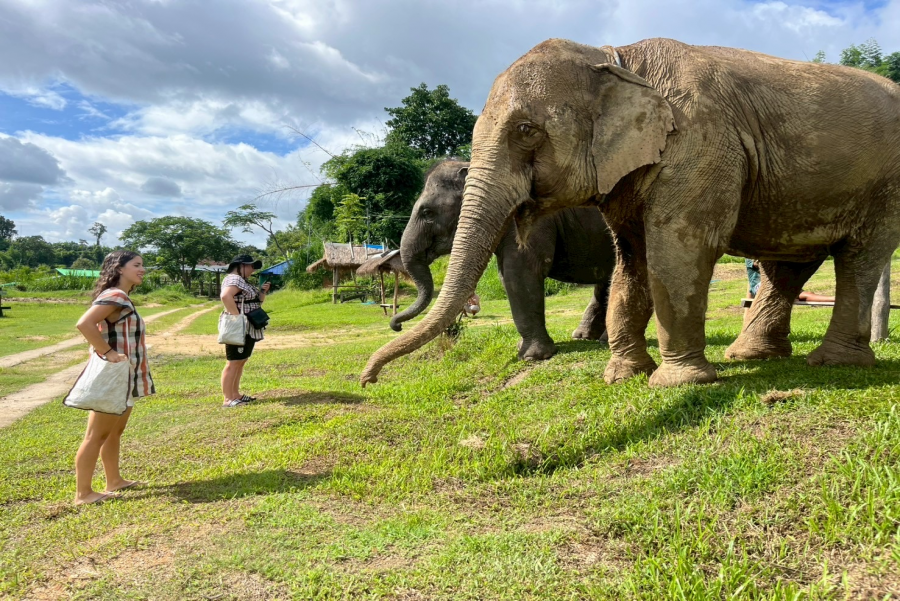
During the day, wild elephants can see no more than 25 feet away. But did you know that elephants substitute their sight for their other senses? They use their trunks (the most important part) to smell things. They swing their trunks in the air to look for unusual smells.
Read more